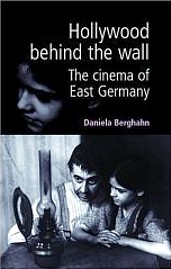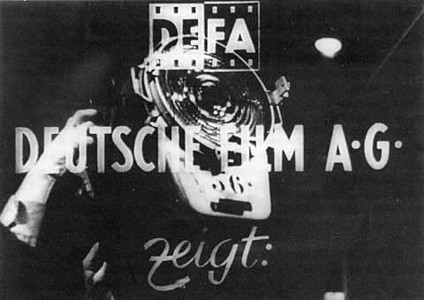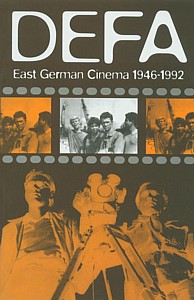|
The eventual budding of the Filmaktiv into the DEFA allowed for complete Soviet influence on the recreation of the German film industry. Initial sponsorship depended wholly on state subsidies with no intention of income. The little profits made through exports were to be taken as reparations by the Soviet Union for a short period. The interlocking nature of the DEFA and the SED cannot be anything less than striking when looking at it in terms of the methodology for reconstruction. The capital which poured into initial investment came from several innocuous entities, but the party was footing the bill for more than a majority. In so doing, the SED held the ultimate tool for controlling an art form that needed big budgets: funding. If monetary subsidies were not the method of making sure the ideological discourse of these the films would be friendly to the cause of socialism, the structure of DEFA filmmaking would. (24-26)
The concept of what has become known in the GDR and, more explicitly, in the DEFA as “self-censorship” was, by Berghahn's account, censorship from the top down. In the GDR from the first ban in 1951 to the fall of the republic in 1989 thirty films were banned before release or during production. The institutionalization of the dramaturge within the DEFA's independent AWG (Artist Work Groups) enabled the revision of scripts much before the production phase. Thus the GDR was capable of avoiding potentially harmful cinematic works that would have challenged the SED's legitimacy at several phases before distribution to the cinemas (30-31).
Perhaps the most indelible aspect of Berghahn's work is the construction of a place within the genre of film for Socialist Realism. She sets the tone by allowing for the doctrinal nature of the genre to be understood as a propagandist tool, but does not discredit it wholly for that reason. Moreover she states, “its original rationale had been driven by genuinely democratic and emancipatory desire, namely to create art for the masses…” (35). This attempt to analyze Socialist Realism within the greater role of the DEFA's productions puts it at odds with the accepted genre of Critical Realism, normally attributed to the West. The main difference, Berghahn emphasizes, is to create a reality as envisioned by the state and not the reality of the individual (39).
Within the Socialist Realist doctrine, the main theme was that of anti-fascism. These works sought the destruction of the “Fuehrer Myth” and all fascist imbedding in German culture. The process of destruction centered on all resistance to the Nazi regime, but particular type of resistance was required. As Andrew Gaskievicz, of the University of Pennsylvania notes, “According to the Marxist critique of fascism, by eliminating the root cause of the Nazi takeover--capitalism--the SED prevented any possibility of a Nazi resurgence”. The most illuminating example, Berghahn points out, was the defiance of the DEFA—or the state's censorship—to produce any works centered around the July plot on Hitler's life. Seen as a reactionary movement of the capitalist classes to stop the death of German Imperialism, the July plot was the wrong type of anti-fascism. Stauffenburg, the would-be assassin, was a symbol of the aristocratic precursor to the Nazi regime, so any idealization of him would constitute veneration of the hierarchy that placed the fascists in power (59).
The symbolic construction of the anti-fascist mentality could be no better represented then in the movie Jacob der Lügner, where, in a sense, the victim becomes the victor. The film was a recreation of the Polish Ghettos, and the life of Jacob, a Jew, helps his compatriots in the ghetto by passing along information to other Jews about the Russian invasion. Too extraordinary for anyone to believe that Jacob was receiving news via the Gestapo, he lies to his friends by telling them he has his own radio. Jacob character seems to be anything other than heroic, Berghahn notes, but the mere hope he provides to his friends of possible salvation is enough for them to carry on. Although not grounded in historical reality, the movie is clear example of the anti-fascist tradition. However, it does stem away, as Berghahn, notes from the accepted tradition of anti-fascism through the communist resistance narrative.
The conception of collective guilt preoccupied much of post-war East Germany, and, as such, the creation of cinematic works that addressed the issue materialized. Die Mörder sind unter uns is no exception. The film attempts to place the greater German populace outside the direct realm of responsibility for the war. Characterized as a rubble film, due to its release in a decimated Germany, the film analyzes the pathos of German society. The level of culpability of an “average” citizen is addressed, and in some ways disregarded as any measure of one's guilt. In the movie a quick visual of a newspaper headline reads, “Millions of people gassed. Report form Auschwitz” (Berghahn 70). No allusion to the victims being Jewish is made. Berghahn suggests that the filmmaker, Staudte, was using the process of Vergangenheitsbewaltigung as a way to provide “impetus” to Germans to think about their role but not directly categorize them as the perpetrators and rather as victims (70).
Lissy may be the classic example of the anti-fascist tradition as seen by the GDR. Adapted from the novel by F.C. Weiskopf, the movie is structured around the title's heroine. Lissy is torn between the life of a petit bourgeois and her communist sympathies. As the Weimar Republic heads further into the troughs of the depression, her husband becomes disillusioned with his existence and finds brotherhood among the SA. Lissy then becomes even more distraught as she tries to weigh her conscience between her commitment to communist ideology and her husband's allegiance to National Socialism. After the death of her brother, who was also in the SA, Lissy becomes further disillusioned, and in the final scene is seen running towards the camera as a narration implies her return to communism. The movie, often criticized for its open-ending, moved to establish in Lissy a measure of an individual's ethos; the push and pull of fascism's draw with the correct mentality, communism, triumphing over false promises of National Socialism. Gaskievicz states in support, “The East German state was established by supposedly heroic communist resistors who fought against the Nazis in concentration camps like Buchenwald. Hence, in DEFA films, other victim groups, most notably Jews, are omitted or completely deemphasized”. (74-77)
It would be foolish to assume that movies that challenged the legitimacy of the ruling party—and their means to attaining power— were never produced. A classic example would be Heiner Carow's Die Russen Kommen (1964), which challenged the myth of Russian liberation at the end of the war and further painted the Red Army as rapists and looters. The movie actually revolved around an adolescent who engages in a conspiracy to kill a Russian worker and then joins the Wehrmacht in an attempt to stave off the final defeat. The reality of the censorship which—if not dominated—played a very real part in the daily lives of DEFA filmmakers would naturally result in the creation of works that challenged all levels of the SED's legitimacy. This movie would wait nearly a decade before being released and was actually destroyed by the state and remained only through hidden copies. (138-141)
The little brother mentality that dominated the course of the GDR saw eventual liberalization of the film industry after the Soviet Union initiated many reforms under the leadership Mikhail Gorbachev. This led to the certification of movies like Die Russen Kommen, and gave rise to the question of how much of the GDR's censorship did not come from the indirect influence of its eastern brother. As Berghahn points out, “Everywhere filmmakers demanded that films which had been banned, often decades ago, be taken off the shelves and shown at last” (144). The reality was that state censorship, which had dominated in the cultural sector of GDR's official policies, had failed to create the utopian vision as prescribed through Socialist Realism. Gaskievicz agrees, “By the 1980s, however, this state-imposed interpretation of the Nazi past was under considerable attack and many East German filmmakers began to admit that East Germans had to consider their share of guilt for the Nazi past as well.” It is almost as though the anti-fascist tradition created a taboo around the subject that created a desire for the issue to be addressed in popular films.
Berghahn attempts a comprehensive overview of the DEFA's cinematic works and how they were produced in communist state. The book, somewhat burdened by heavy use of statistics and figures, presents the narrative of the DEFA with surprising clarity and detail, but the use of comparative figures suggests that the industry was relatively weak next to the west and other eastern satellites. However, that fact does not detract from the richness of the DEFA's productions; these films—although controlled by various means—were representative of a unique culture. The culture, on the other hand, essentially outgrew the structure provided and the GDR, as a whole, crumbled because of it. |


